
–– The newsletter on wine and wine travel ––
–– Read by wine lovers and wine professionals all over the world ––
–– On the internet since 1996 ––
Small-scale always best?
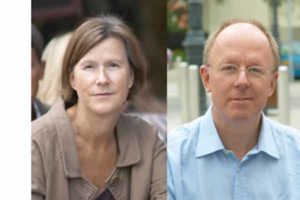 Many wine lovers tend to prefer smaller wineries. And the wine world has plenty of them. Do small scale wines have more personality and character than the big ones? Perhaps.
Many wine lovers tend to prefer smaller wineries. And the wine world has plenty of them. Do small scale wines have more personality and character than the big ones? Perhaps.
We often buy wine from the small producers. Not always because they are the best (and what does that mean, the “best”?). We rather patronise the small producers than giants like LVMH, Gallo, Penfolds, Gérard Bertrand, Allegrini and others.
We imagine that the smaller ones need our money more than, for example, Bernard Arnault, France’s richest man and the man behind LVMH (Moët & Chandon, Veuve Clicquot, Krug, Dom Pérignon, Ruinart, Cloudy Bay, Cape Mentelle and others). But yes, we often think that there is more character in the wines from the small winegrowers. Maybe it is easier to be daring if you are responsible for everything yourself, rather than an employed winemaker facing grim management that wants to see a profit every year. (Nothing wrong with profits, of course.)
If you, for instance, consider sustainability and not least “fair trade” and the like important, then perhaps you prefer to favour those who do not have much, the small producers who often struggle to survive, rather than those who already have everything and more?
On the other hand, behind every wine giant, there are, of course, lots of small farmers. The giants never own enough vineyards. Moët & Chandon probably buys grapes from a couple of thousands of small grape growers. Add to that the fact that almost 50% of all French wine comes from cooperatives. And cooperatives consist of small farmers. Small-scale farming is everywhere, in different forms.
A small family-run wine business that owns its vineyards and does everything from A to Z is the very image of a winegrower in most people’s minds. As a consumer, maybe you feel closer to the whole process when enjoying such a wine, making you like the wine better. But like much else today, it is not so straightforward.
It also has to do with the fact that drinking wine is more than just consuming a drink. Michel Chapoutier makes brilliant wines, but he is hardly the one who made the wine. Maybe he has a dozen winemakers employed. But if you drink a wine from Domaine de Mourchon (see one of the items in this month’s Brief), you know that the McKinley family stood in the cellar and pumped. Wine is also about the people behind the wine.
The size is not always easy to determine, nor if the wine has been made from own or purchased grapes. Today, in upscale wine regions such as Burgundy and Champagne, no one can afford to buy land. If you want to expand your business as a small grower, the only option is to rent vineyards or buy grapes and thus become a négociant.
And it does not have to be such extreme cases as these two regions where vineyard prices reach stratospheric heights. Even in other places, it is not obvious to buy vineyards if you start out as a winegrower (few have the privilege of inheriting their land). In South Africa today, several exciting producers have no vineyards at all but go around the country looking for grapes, often from vineyards that are on the brink of being abandoned. The result is excellent.
The boundaries are blurred. As a wine lover, you mustn’t be too categorical. Still, we love to know the name of the person who really made the wine.
Wine tours
The whole world is hibernating. But now it’s starting to look brighter, quite literally to begin with. In Paris, we have 25 degrees C in the air, exceptional for the end of March. The Magnolia in the park is even starting to shed its flowers.
But far more important than that, the world has started getting vaccinated. Admittedly, it’s going too slow (no matter how fast, it is still too slow), but it’s on its way.
We begin to feel that now we can see the light twinkling at the end of the tunnel. Now we can start hoping to really get going on those travel adventures that everyone have longed for, for so long.
So, we hope for a fresh start to wine travel in the autumn. We have been busy putting together some exciting travel programmes.
We have the classic regions of Champagne and Bordeaux planned for you in the fall and the winter program for 2022 well underway with Chile-Argentina, South Africa and New Zealand. All is set to go. We’re just waiting for you.
Dream yourself away and then take action, go for it. Join us at BKWine on a wine tour.
We look forward at least as much as you do to meet in a vineyard somewhere and enjoy some really good wines, good food and great company.
Enjoy the Brief!
Britt & Per
If you appreciate what we do, you can help us:Tell your friends about the Brief or send it to them.
Like us and follow us on social media:
What’s on at BKWine Tours
BKWine is also one of the world’s leading wine tour operators. Here’s what we currently have on our scheduled wine tour program:
- Champagne and Bordeaux, September 23 – October 1 2021
- Champagne, September 23-27, 2021
- Bordeaux, September 27 – October 1, 2021
- Chile-Argentina, January 17-30, 2022
- South Africa, February 9-18, 2022
- New Zealand, March 10-25, 2022
We also make custom designed wine tours.
We’re different than most other wine tour operators. We are people who know wine inside out, who travel constantly in wine regions, who write award winning books about wine. Who do this out of passion. Our tours are different from others. More in wine tours: BKWineTours.com.
Read our books
We have written several wine books, ten at the last count. Unfortunately, only one of them has been translated to English; the others are (so far) only available in Swedish. This is the one that is available in English:
All our books are on wine, but on different subjects: wines of the Languedoc, wine growing and wine making, the wines of France, Tuscany, Bordeaux, Piedmont, Burgundy, Champagne. Several have won prestigious prizes and awards from Gourmand International, OIV and others. Read more on our wine books.
News from the world of wineWhat’s been happening in the world of wine recently. |
Formula 1: Out with champagne, in with Ferrari Trentodoc
It is an achievement, and we congratulate the Lunelli family, who runs the company Ferrari in Trentino in northern Italy. The family has made itself a big name around the world thanks to its sparkling wines. As tradition dictates, the Ferrari bottle that will be shaken up at the podium will be a jeroboam, i.e., a 3-litre bottle. Read more: ferraritrento |
Can essential oil from orange peel protect the vineyard?
Today, the market offers many different products where orange oil is included as an active substance. Oro Agri, one manufacturer, is doing research into how best to use this sustainable plant protection, in what doses and when to spray. It is vital not to use too much as the oil can desiccate the grape skin. The orange oil is also approved for use as an insecticide. Experiments show that the oil has a minimal effect on bees and other good insects that you want to keep in the vineyard. Read more vitisphere |
Aranda de Duero is the European Wine City of the Year in 2022
Aranda de Duero is, of course, a perfect base for exploring the Ribera del Duero’s many excellent wine estates. The surrounding nature is dramatically beautiful. The vineyards are located at high altitudes, between 720 and 1100 meters above sea level. The hot and dry summers that cool down significantly at night give the red wines the concentration and structure for which they have become famous. Other Spanish wine cities that have received the award are Cambados in Galicia, known for its albariño, and the sherry town of Jerez de la Frontera in Andalusia. In 2019, the Sannio region of Campania in Italy was the European wine capital of the year. Read more mercadosdelvino. |
Excellent quality vintage 2020 in Washington with cabernet franc on the rise
Cabernet sauvignon accounted for 29% of the total harvest, with chardonnay in second place with 16%, followed by riesling, merlot and syrah. These five together accounted for 80%. Many more grapes, around 65 in total, are grown in small areas in the state. The grape price was slightly higher than in 2019. The grape growers received an average of 1.50 USD per kilo, a pretty good price globally if one disregards Napa and Champagne, which have exceptionally high grape prices. Cabernet franc was the highest valued grape at 2.17 USD per kilo. Cabernet franc is currently planted on just under 300 hectares in Washington, but the area has grown six-fold in recent years. It seems that this grape has everything going for it right now, all over the world. Read more about the 2020 harvest in Washington here winebusiness. |
New grape varieties in Burgundy due to climate change? Or maybe just new clones?
One good idea is to search among the many clones with varying characteristics that the two grapes have. Among the clones, there is great diversity. Growers can also choose a rootstock that better withstand drought and heat. But experiments with other grape varieties were also recommended. Savagnin from the Jura with its beautifully high acidity was mentioned, as well as the Greek assyrtiko. Among the red grapes, syrah, xinomavro from northern Greece and nebbiolo were mentioned as suitable for the Burgundian terroir. But this is long-term planning, Jean-Michel Boursiquot, professor of ampelography, pointed out. Wine producers are allowed to experiment with “foreign” grape varieties, so-called VIFA, varietés d’intérêt à fin d’adaptation, on 5% of their vineyard surface. They may be part of the wine by up to 10%. Vinosphère Bourgogne is organised by the Bureau interprofessionnel des vins de Bourgogne (BIVB). Read more vinosphere-bourgogne. |
The white asparagus, the most delicious of springtime primeurs
Here are five spring-like wine suggestions. These five grapes, assyrtiko, chenin blanc, albariño, grüner veltliner and sauvignon blanc, will accompany your white asparagus splendidly.
Watch this film to see the asparagus harvest in Les Landes francetvinfo. Travel: Les Landes is next-door to Bordeaux where you will find plenty of delicious things, for example on our wine tour to Bordeaux. |
Spring report from Fixin in Burgundy: bud break is imminent
It is currently warm, which, combined with moist soil, causes the buds to develop rapidly. The buds in the Côte d’Or are now “dans le coton”, which is the stage that follows the rise of the sap when the vine “weeps” (dripping out of the pruning cuts). The most developed vineyards have already reached the next stage, “pointe verte”, meaning that the bud has continued to swell and started to turn green. The next stage, maybe in a week or so, is bud break. At that time, it is crucial to have a constant eye on the weather report. Philippe is now using the time to do new plantings. “I like to plant new vines in the spring because I ‘work’ for my grandchildren, and I hope they continue…”. |
FeaturesArticles and features published on BKWine Magazine and on our wine travel blog and photography blog in the last month. |
One of the most famous wines from Chile has a French pedigree | Britt on Forbes
Read more in Britt’s article on BKWine Magazine, originally published on Forbes: Lapostolle and Clos Apalta, Chilean wines with a French touch | Britt on Forbes. Travel: Travel to Chile and Argentina on a wine tour with BKWine. |
Small family-run ‘Wine & Soul’ challenging the big port wine houses, great reds and whites as a bonus | Britt on Forbes
Read more in Britt’s article on BKWine Magazine, originally published on Forbes: Meet Wine & Soul, excellent red wines and not only Port in the Douro Valley | Britt on Forbes. Travel: Travel to Douro Valley on a wine tour with BKWine. |
Caprettone, a native grape variety that thrives on Vesuvius in Campania
Read more in Åsa’s article on BKWine Magazine: Caprettone, a native grape variety that thrives on Vesuvius in Campania. |
Clos De Los Siete, the story behind the successful Argentinean brand created by celebrity consultant Michel Rolland | Britt on Forbes
Read more in Britt’s article on BKWine Magazine, originally published on Forbes: Clos de los Siete, a fantastically successful wine from Argentina with an unusual concept | Britt on Forbes. Travel: Travel to Chile and Argentina on a wine tour with BKWine. |
Grenache, an unsung hero in the vineyards| Grape Variety Profile | Britt on Forbes
Read more in Britt’s article on BKWine Magazine, originally published on Forbes: Grenache, hard-working and discreet, but brilliant | Grape Variety Profile | Britt on Forbes. This is an article in our series of presentations of the world’s most popular and exciting grape varieties. |
Uncorked: Good wines we have tasted recently, March 2020
This month: Surprisingly pleasant dry muscat, legendary wine from Napa Valley, matured wines from Champagne, Bordeaux and Hermitage, delicious carignan, unusual white varieties from Piedmont, fantastic syrah from New Zealand. And much more. Read more in Britt’s article on BKWine Magazine: Uncorked: Good wines we have tasted recently, March 2020. |
Ornellaia 2018 launched, a graceful and elegant vintage
Read more in Åsa’s article on BKWine Magazine: Ornellaia 2018 launched, a graceful and elegant vintage. |
The Japanese Saké Bible | book review
Read more in Per’s article on BKWine Magazine: The Japanese Saké Bible | book review |
New rules promote organic vineyards and long ageing; Eva Plazas At Cava Vilarnau explains | Britt on Forbes
Read more in Britt’s article on BKWine Magazine, originally published on Forbes: Four wines from Caves Vilarnau illustrate the new quality-promoting cava rules in Catalonia | Britt on Forbes. |
A Piedmont wine treasure that was almost lost, but was saved from extinction: Timorasso | Per on Forbes
Read more in Per’s article on BKWine Magazine, originally published on Forbes: A Piedmont wine treasure that was almost lost, but was saved from extinction: Timorasso | Per on Forbes. |
Rosé wine from cannonau and monica from southern Sardinia
Read more in Åsa’s article on BKWine Magazine: Rosé wine from cannonau and monica from southern Sardinia. |
VeriVin, a tech start-up with a solution that might eliminate wine fraud | Per on Forbes
Read more in Per’s article on BKWine Magazine, originally published on Forbes: VeriVin, a tech start-up with a solution that might eliminate wine fraud | Per on Forbes. |
Wine ToursSome information on our current and future wine tours. Book a wine tour with the “world’s top wine tour operator” today (or when you feel like travelling to wine country). |
Champagne, picturesque and amazing | wine tour
We will go to the big houses and to small growers. They work differently but are both an essential part of the champagne industry. Our extensive tastings will give you a feel for the many different styles of champagne. You will enjoy our lunches, either at Champagne-houses or at superb, local restaurants. Hope to see you in Champagne! Wine tour to Champagne, September 23-27, 2021 We also offer a combined Champagne and Bordeaux wine tour. See more on this in a separate note. Book your tour to now! |
Bordeaux, a dynamic reference in the wine world | wine tour
Bordeaux is mainly a red wine region, and our focus will be on the red wines from Médoc, Graves and Saint Emilion. Bordeaux has magnificent chateaux, and we will visit some of them, both the big and famous and the smaller, family-owned. We will also have the opportunity to taste the magnificent white wines and the sweet wines from Sauternes. Experience Bordeaux with us. Wine tour to Bordeaux, September 27 – October 1 Wine tour to Bordeaux, September 27 – October 1 We also offer a combined Bordeaux and Champagne wine tour. See more on this in a separate note. Book your tour to now! |
Champagne and Bordeaux combined: the two most famous French wine regions | wine tour
Our days in Champagne will give you a feeling of how the big houses and the smaller growers work and how they make their champagnes. We will discuss all the details of the winemaking process, which is special in Champagne. Our lunches will allow you to learn how to match champagne with food. The high-speed train will take us to Bordeaux in the south west of France. This is an incredibly beautiful city, situated by the river Garonne. Take the time to stroll around and admire the old houses along the quay. You will enjoy Médoc and Graves with its classic chateaux and cabernet sauvignon-based wines as well as smaller family estates in Saint Emilion, where merlot is the most prominent grape variety. Our lunches at the chateaux will be a match for Michelin star restaurants. Join us and discover two unique and classic French wine regions. Wine tour to Champagne and Bordeaux, September 23 – October 1, 2021. Book your tour to now! |
The best Malbec and Carmenère wines, inspiring winemakers, exceptional mountains and enjoyable lunches | wine tour in South America
Wine tour to Chile-Argentina, January 17-30, 2022. Book your tour to South America now! |
Great wine experiences and fantastic scenery in Stellenbosch, Swartland, Walker Bay, Franschhoek and other regions | wine tour in South Africa
Although Stellenbosch is the heart of the wine industry, with its university and its many well-known wine estates, the slightly more peripheral districts are becoming more and more famous. Like for example, Swartland in the north and Walker Bay and Elgin in the south. We visit these regions on our tour and, of course, also Stellenbosch and Franschhoek. We will have a few days in Cape Town when we admire the view from Table Mountain, get to know the Cape Malay cuisine and visit the Cape of Good Hope. Few wine countries beat South Africa when it comes to beautiful scenery and wow-feeling. Wine tour to South Africa, 9-18 February 2022. Book your tour to South Africa now! |
Auckland, Wellington, Queenstown, and wine regions on the North and South Islands | wine tour in New Zealand
Our next wine region is Wairarapa, where they make some fantastic pinot noir. We spend a few hours in Wellington, the capital before it’s time to take the ferry to the South Island. Here our first stop is Marlborough, the region that made the country famous. As you will see, sauvignon blanc comes in many forms. We make a detour to Mount Cook, New Zealand’s highest mountain, and then we end the tour in Central Otago, beautiful and spectacular. Cool climate grapes thrive here, not least pinot noir. Join us on this adventure in a faraway country. Wine tour to New Zealand, March 10-25, 2022. Book your tour to New Zealand now! |


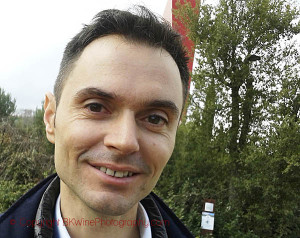 For as long as we can remember, the lucky winner of the Formula 1 races has celebrated with bottles of champagne. But not anymore. Ferrari Trentodoc has been named the Formula 1 race’s “Official Sparkling Wine” from 2021. For the first time in history (presumably), it is a sparkling wine other than champagne that gets this honour.
For as long as we can remember, the lucky winner of the Formula 1 races has celebrated with bottles of champagne. But not anymore. Ferrari Trentodoc has been named the Formula 1 race’s “Official Sparkling Wine” from 2021. For the first time in history (presumably), it is a sparkling wine other than champagne that gets this honour.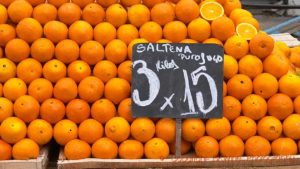 Essential oil from orange peel has a drying effect on the vine, it is desiccating. Therefore, many organic wine producers use this product to complement sulphur and copper in the fight against mildiou and oidium that thrive in humidity. Today, 3% of France’s wine-growing area is protected by orange essential oil and a significant increase is expected in the coming years.
Essential oil from orange peel has a drying effect on the vine, it is desiccating. Therefore, many organic wine producers use this product to complement sulphur and copper in the fight against mildiou and oidium that thrive in humidity. Today, 3% of France’s wine-growing area is protected by orange essential oil and a significant increase is expected in the coming years.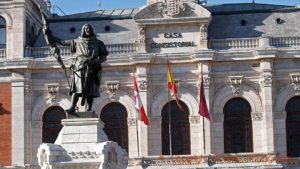 Aranda de Duero is located in the heart of the Spanish wine region of Ribeira del Duero. In 2020, the city, which has just over 30,000 inhabitants, was named “European Wine City of the Year” by the European Network of Wine Cities (RECEVIN). Since no one had the opportunity to go there last year and it does not look promising for major events in 2021 either, it has now been decided that this appointment will also apply for 2022.
Aranda de Duero is located in the heart of the Spanish wine region of Ribeira del Duero. In 2020, the city, which has just over 30,000 inhabitants, was named “European Wine City of the Year” by the European Network of Wine Cities (RECEVIN). Since no one had the opportunity to go there last year and it does not look promising for major events in 2021 either, it has now been decided that this appointment will also apply for 2022.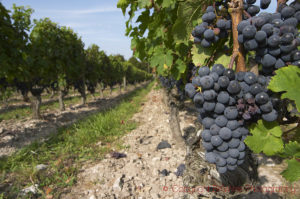 Washington’s wine producers have summed up the 2020 vintage. The volume was slightly smaller than in 2019, but they are delighted with the quality. In addition to the pandemic, there were weather problems to deal with, e.g. rain and wind during flowering and fires at harvest time.
Washington’s wine producers have summed up the 2020 vintage. The volume was slightly smaller than in 2019, but they are delighted with the quality. In addition to the pandemic, there were weather problems to deal with, e.g. rain and wind during flowering and fires at harvest time.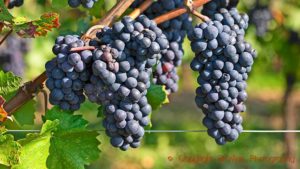 During the webinar “Vinosphere Burgundy” at the end of February, researchers discussed various possibilities to tackle climate change. The question was: Will Burgundy be forced to abandon pinot noir and chardonnay? The reassuring message was that it is not necessary. Not yet anyway. Before changing grapes, there are various ways to make pinot and chardonnay more adaptable.
During the webinar “Vinosphere Burgundy” at the end of February, researchers discussed various possibilities to tackle climate change. The question was: Will Burgundy be forced to abandon pinot noir and chardonnay? The reassuring message was that it is not necessary. Not yet anyway. Before changing grapes, there are various ways to make pinot and chardonnay more adaptable.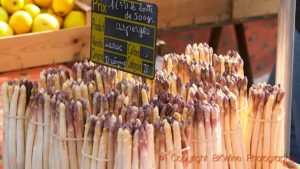 The best springtime primeur is the white asparagus. Two weeks ago, in mid-March, asparagus from Les Landes, just south of Bordeaux, arrived at our food market (in Paris). In Les Landes, the asparagus grows in sandy soil, which is supposed to make the asparagus very tender. It is thanks to this sand, say the growers, that the asparagus from Les Landes obtained its IGP in 2005 (one notch under AOP). As soon as the top part peers over the surface, it must be harvested to retain its white colour. After just one hour in the sun, it starts to turn green. Now it’s time to enjoy this delicacy. The season will be over in early June. White asparagus can be prepared in many different ways, but at the start of the season, we prefer to keep it simple and serve it boiled with salt and melted butter.
The best springtime primeur is the white asparagus. Two weeks ago, in mid-March, asparagus from Les Landes, just south of Bordeaux, arrived at our food market (in Paris). In Les Landes, the asparagus grows in sandy soil, which is supposed to make the asparagus very tender. It is thanks to this sand, say the growers, that the asparagus from Les Landes obtained its IGP in 2005 (one notch under AOP). As soon as the top part peers over the surface, it must be harvested to retain its white colour. After just one hour in the sun, it starts to turn green. Now it’s time to enjoy this delicacy. The season will be over in early June. White asparagus can be prepared in many different ways, but at the start of the season, we prefer to keep it simple and serve it boiled with salt and melted butter.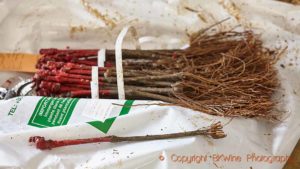 Philippe Bernard at Clos Saint Louis in Fixin in the Côte de Nuits has sent a greeting and some information about how the vine is on the brink of a new growing season. “2021 has so far been a normal year,” he says. “In Burgundy, this means some rain, some snow and some cold temperatures.”
Philippe Bernard at Clos Saint Louis in Fixin in the Côte de Nuits has sent a greeting and some information about how the vine is on the brink of a new growing season. “2021 has so far been a normal year,” he says. “In Burgundy, this means some rain, some snow and some cold temperatures.” Chile has its fair share of French wine producers. And who can blame the French for trying their luck here? Chile is a magnificent country for viticulture. In 1994 Alexandra Marnier Lapostolle fell in love with the Colchagua Valley and, more specifically, a small part of it called Apalta Valley. She launched Lapostolle Wines, and very soon after, she gained fame for her wines Clos Apalta and Cuvée Alexandre.
Chile has its fair share of French wine producers. And who can blame the French for trying their luck here? Chile is a magnificent country for viticulture. In 1994 Alexandra Marnier Lapostolle fell in love with the Colchagua Valley and, more specifically, a small part of it called Apalta Valley. She launched Lapostolle Wines, and very soon after, she gained fame for her wines Clos Apalta and Cuvée Alexandre.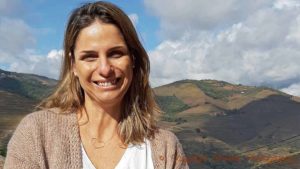 You can find some of Portugal’s best red and white wines in the Douro Valley. A renaissance has taken place in this region in the last few decades, previously only known for port wine. Wine & Soul is one of the pioneers. When Sandra Tavares and Jorge Borges started Wine & Soul in 2001, their aim was to show the world that the Douro Valley can produce high-quality red wines. Nobody doubts that today. We met Sandra in October 2020 on one of our very few wine tours that autumn. She told us how it all started.
You can find some of Portugal’s best red and white wines in the Douro Valley. A renaissance has taken place in this region in the last few decades, previously only known for port wine. Wine & Soul is one of the pioneers. When Sandra Tavares and Jorge Borges started Wine & Soul in 2001, their aim was to show the world that the Douro Valley can produce high-quality red wines. Nobody doubts that today. We met Sandra in October 2020 on one of our very few wine tours that autumn. She told us how it all started.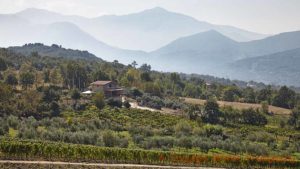 Caprettone is a grape that until recently was often confused with coda di volpe, another native grape variety from Campania. A small group of wine producers are now making a big effort to bring caprettone into the spotlight. One of them is Casa Setaro on the black slopes of Vesuvius. A wine producer that you should keep on your radar.
Caprettone is a grape that until recently was often confused with coda di volpe, another native grape variety from Campania. A small group of wine producers are now making a big effort to bring caprettone into the spotlight. One of them is Casa Setaro on the black slopes of Vesuvius. A wine producer that you should keep on your radar. We talk to Michel Rolland who explains the curious idea behind the success of Clos de Los Siete from Mendoza. Michel Rolland from Bordeaux is the world’s most famous wine consultant. His clients can be found all over the world, not least in South America. When Michel first tasted the wines from Argentina in 1988, they hadn’t yet made a big impact on the world of wine. And Michel understood why. He really didn’t like them very much. He knew they had to change. Through his consulting business, he helped that happen. Some ten years later, the export figures had skyrocketed. In between consulting assignments, he also had time to buy land, find investors and create a successful brand called Clos de los Siete.
We talk to Michel Rolland who explains the curious idea behind the success of Clos de Los Siete from Mendoza. Michel Rolland from Bordeaux is the world’s most famous wine consultant. His clients can be found all over the world, not least in South America. When Michel first tasted the wines from Argentina in 1988, they hadn’t yet made a big impact on the world of wine. And Michel understood why. He really didn’t like them very much. He knew they had to change. Through his consulting business, he helped that happen. Some ten years later, the export figures had skyrocketed. In between consulting assignments, he also had time to buy land, find investors and create a successful brand called Clos de los Siete. Grenache was the first grape variety I ever harvested. It was in Banyuls in southern France, a beautiful vineyard by the Mediterranean Sea. Big bunches with ripe grapes. Maybe that is why I like it so much. It is a hard-working grape and quite discreet. It doesn’t boast its name on the label very often. That means that for some people, it is a somewhat anonymous grape. But actually, it is anything but. Here’s an introduction to this excellent grape variety.
Grenache was the first grape variety I ever harvested. It was in Banyuls in southern France, a beautiful vineyard by the Mediterranean Sea. Big bunches with ripe grapes. Maybe that is why I like it so much. It is a hard-working grape and quite discreet. It doesn’t boast its name on the label very often. That means that for some people, it is a somewhat anonymous grape. But actually, it is anything but. Here’s an introduction to this excellent grape variety.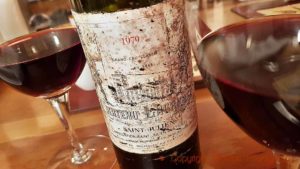 Under this heading, we collect various wines that we have tasted, and liked, recently. It can be wines that we have had during dinner at home, at wine tastings, press lunches, visits to vineyards, or other occasions.
Under this heading, we collect various wines that we have tasted, and liked, recently. It can be wines that we have had during dinner at home, at wine tastings, press lunches, visits to vineyards, or other occasions.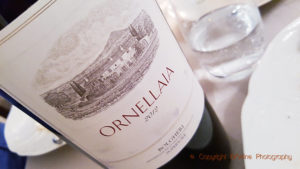 Ornellaia, one of the world’s most prestigious wineries, has just released the new 2018 vintage. Every year since 2009, an artist is commissioned to illustrate the label on a theme that corresponds to the vintage. These handmade labels adorn 111 custom-made bottles sold at a charity auction. The theme for 2018 was the Italian word “grace”, a graceful vintage. This is how the wine is.
Ornellaia, one of the world’s most prestigious wineries, has just released the new 2018 vintage. Every year since 2009, an artist is commissioned to illustrate the label on a theme that corresponds to the vintage. These handmade labels adorn 111 custom-made bottles sold at a charity auction. The theme for 2018 was the Italian word “grace”, a graceful vintage. This is how the wine is.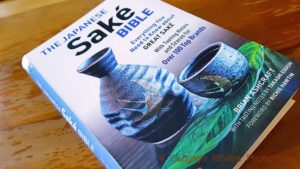 Not only wine is worth drinking. Saké too. That is certainly Brian Ashcraft’s conviction. He tries to convey all his passion for sake and all his knowledge (or at least a good part of it) in his book The Japanese Saké Bible. And he does an excellent job of it.
Not only wine is worth drinking. Saké too. That is certainly Brian Ashcraft’s conviction. He tries to convey all his passion for sake and all his knowledge (or at least a good part of it) in his book The Japanese Saké Bible. And he does an excellent job of it.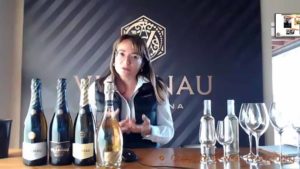 Four wines from Caves Vilarnau illustrate the new quality-promoting cava rules in Catalonia. Winemaker Eva Plazas Torné has been working for the cava producer Caves Vilarnau since 1996. In other words, she has a solid experience of how to make the best cava. Now she wants consumers to realize that cava is not only the inexpensive bubbly they have come to expect, that cava can holds its own against the world’s top sparkling wines, if well-made. We met Eva Plazas Torné in Sant Sadurni d’Anoia on Zoom to hear more about how the world of cava is reinventing itself. And to illustrate her point we tasted a range of four Vilarnau wines, from entry-level to top-of-the range barrel aged.
Four wines from Caves Vilarnau illustrate the new quality-promoting cava rules in Catalonia. Winemaker Eva Plazas Torné has been working for the cava producer Caves Vilarnau since 1996. In other words, she has a solid experience of how to make the best cava. Now she wants consumers to realize that cava is not only the inexpensive bubbly they have come to expect, that cava can holds its own against the world’s top sparkling wines, if well-made. We met Eva Plazas Torné in Sant Sadurni d’Anoia on Zoom to hear more about how the world of cava is reinventing itself. And to illustrate her point we tasted a range of four Vilarnau wines, from entry-level to top-of-the range barrel aged.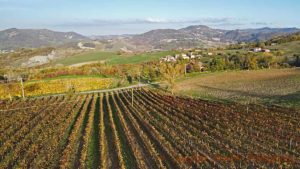 Timorasso is the name of a rare Piedmontese grape variety. It had almost disappeared; barely a hectare remained when a winemaker near the town of Tortona decided to save it. We should all be grateful to Walter Massa since timorasso is undoubtedly one of the most interesting white grape varieties of Piedmont, or perhaps even of the whole of Italy, giving great wines of both elegance and depth. Here’s the story of DOC Colli Tortonesi Timorasso and some wines to look for.
Timorasso is the name of a rare Piedmontese grape variety. It had almost disappeared; barely a hectare remained when a winemaker near the town of Tortona decided to save it. We should all be grateful to Walter Massa since timorasso is undoubtedly one of the most interesting white grape varieties of Piedmont, or perhaps even of the whole of Italy, giving great wines of both elegance and depth. Here’s the story of DOC Colli Tortonesi Timorasso and some wines to look for.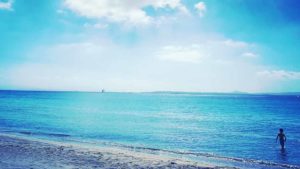 Just outside Cagliari in southern Sardinia, the Mora&Memo farm makes intensely fruity wines from native grape varieties. For example, a rosé made on cannonau and monica, an unusual blend from this beautiful island. Meet Elisabetta Pala, who started the winery in 2013.
Just outside Cagliari in southern Sardinia, the Mora&Memo farm makes intensely fruity wines from native grape varieties. For example, a rosé made on cannonau and monica, an unusual blend from this beautiful island. Meet Elisabetta Pala, who started the winery in 2013.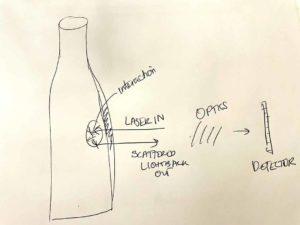 Is VeriVin SWA001 the Holy Grail to fight wine fraud? Wine fraud can be of the spectacular kind of selling fake Romanée-Conti, or it can be of a more mundane type, selling bulk wine that is not what it pretends to be. In both cases, there can be a lot of money at stake. There are two big difficulties with fighting wine fraud. First, the wine is often in a closed container (a bottle) that can’t be opened and sampled. Second, wine is such a complex liquid, so it is difficult to make an accurate analysis. VeriVin is a new technology developed by an Oxford start-up that might solve these problems with counterfeit wines. I talked with the founder of VeriVin, Cecilia Muldoon.
Is VeriVin SWA001 the Holy Grail to fight wine fraud? Wine fraud can be of the spectacular kind of selling fake Romanée-Conti, or it can be of a more mundane type, selling bulk wine that is not what it pretends to be. In both cases, there can be a lot of money at stake. There are two big difficulties with fighting wine fraud. First, the wine is often in a closed container (a bottle) that can’t be opened and sampled. Second, wine is such a complex liquid, so it is difficult to make an accurate analysis. VeriVin is a new technology developed by an Oxford start-up that might solve these problems with counterfeit wines. I talked with the founder of VeriVin, Cecilia Muldoon.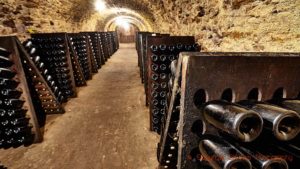 Champagne is just one part of the world production of sparkling wine but, of course, an important part, measured in value (and reputation) not least. Join us on our tour to Champagne, and you will learn all the things that set champagne apart: the soil, the climate that gives the lovely acidity to the wines, the winemaking process, the importance of the long ageing in the cellar. Champagne is a picturesque region, with vineyards on slopes and charming villages. We will stay in Reims, with its UNESCO Heritage cathedral, and we will have a quick visit to Epernay as well.
Champagne is just one part of the world production of sparkling wine but, of course, an important part, measured in value (and reputation) not least. Join us on our tour to Champagne, and you will learn all the things that set champagne apart: the soil, the climate that gives the lovely acidity to the wines, the winemaking process, the importance of the long ageing in the cellar. Champagne is a picturesque region, with vineyards on slopes and charming villages. We will stay in Reims, with its UNESCO Heritage cathedral, and we will have a quick visit to Epernay as well.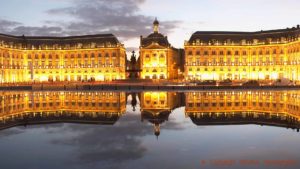 Bordeaux is a reference in the wine world. Wine producers everywhere have been influenced and inspired by Bordeaux. The region’s grapes have spread across the globe. Bordeaux is part of the history of wine. But you cannot live on old merits; they know that in Bordeaux. You will find that Bordeaux today is a dynamic region, working hard to please wine lovers worldwide.
Bordeaux is a reference in the wine world. Wine producers everywhere have been influenced and inspired by Bordeaux. The region’s grapes have spread across the globe. Bordeaux is part of the history of wine. But you cannot live on old merits; they know that in Bordeaux. You will find that Bordeaux today is a dynamic region, working hard to please wine lovers worldwide.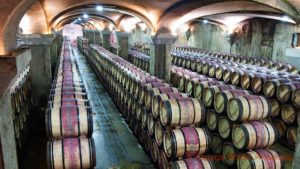 Now you don’t have to choose whether to go to Bordeaux or Champagne. You can go to both of them. This tour combines these two great regions during an intense 9-day tour. We will stay in Reims in Champagne for four nights and in Bordeaux for four nights. Both these cities are lovely to explore in your free time.
Now you don’t have to choose whether to go to Bordeaux or Champagne. You can go to both of them. This tour combines these two great regions during an intense 9-day tour. We will stay in Reims in Champagne for four nights and in Bordeaux for four nights. Both these cities are lovely to explore in your free time.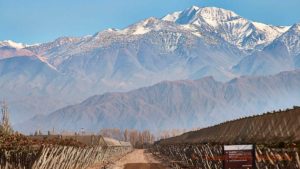 The vast mountain range of the Andes forms the border with Chile. We get in close contact with these incredible mountains when we take our bus across to Chile. Once on the other side, the landscape changes. Chile is a very long and narrow country. The vineyards are never far from either the Pacific Ocean or the Andes. We start with a few days in the slightly cooler seaside regions of Casablanca and San Antonio before we drive inland to Colchagua, where they make some of the country’s best red wines, from Chile’s national grape carmenère and from many others. We visit some of the sub-districts that have crystallized and made themselves a name in recent years, such as Apalta and Lolol. The quality of the wines is impressively high. We have time for Valparaiso, a must when you are in Chile, and of course, a quick look-around in Santiago de Chile.
The vast mountain range of the Andes forms the border with Chile. We get in close contact with these incredible mountains when we take our bus across to Chile. Once on the other side, the landscape changes. Chile is a very long and narrow country. The vineyards are never far from either the Pacific Ocean or the Andes. We start with a few days in the slightly cooler seaside regions of Casablanca and San Antonio before we drive inland to Colchagua, where they make some of the country’s best red wines, from Chile’s national grape carmenère and from many others. We visit some of the sub-districts that have crystallized and made themselves a name in recent years, such as Apalta and Lolol. The quality of the wines is impressively high. We have time for Valparaiso, a must when you are in Chile, and of course, a quick look-around in Santiago de Chile.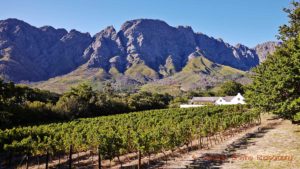 The world has only really had South African wines since apartheid ended in the early 1990s. Now, these wines are a natural and important part of the wine world. And the wines are magnificent. Quality is now everywhere, from small experimental natural wine producers to the giant KWV. Outstanding wines from South Africa are reasonably priced. Add a few extra euros, and the experience will be even greater.
The world has only really had South African wines since apartheid ended in the early 1990s. Now, these wines are a natural and important part of the wine world. And the wines are magnificent. Quality is now everywhere, from small experimental natural wine producers to the giant KWV. Outstanding wines from South Africa are reasonably priced. Add a few extra euros, and the experience will be even greater.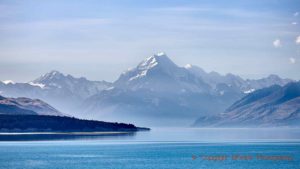 When sauvignon blanc from New Zealand took the world by storm in the 1980s, müller-thurgau was still the most widely planted grape in the country. Now this grape is a thing of the past, and sauvignon blanc is by far the most planted. But definitely not the only one, as you will notice on our magnificent tour through New Zealand. We spend a few days in Auckland, the largest city. We take the ferry to Waiheke Island to taste the famous Bordeaux-blends. Then we travel south, with Hawke’s Bay as our first stop (after the sulphurous geysers). It is a wine region with a long history. The country’s oldest wine estate, Mission Estate, was founded here in Hawke’s Bay in the 1850s. Our hotel is in the art deco town of Napier.
When sauvignon blanc from New Zealand took the world by storm in the 1980s, müller-thurgau was still the most widely planted grape in the country. Now this grape is a thing of the past, and sauvignon blanc is by far the most planted. But definitely not the only one, as you will notice on our magnificent tour through New Zealand. We spend a few days in Auckland, the largest city. We take the ferry to Waiheke Island to taste the famous Bordeaux-blends. Then we travel south, with Hawke’s Bay as our first stop (after the sulphurous geysers). It is a wine region with a long history. The country’s oldest wine estate, Mission Estate, was founded here in Hawke’s Bay in the 1850s. Our hotel is in the art deco town of Napier.





